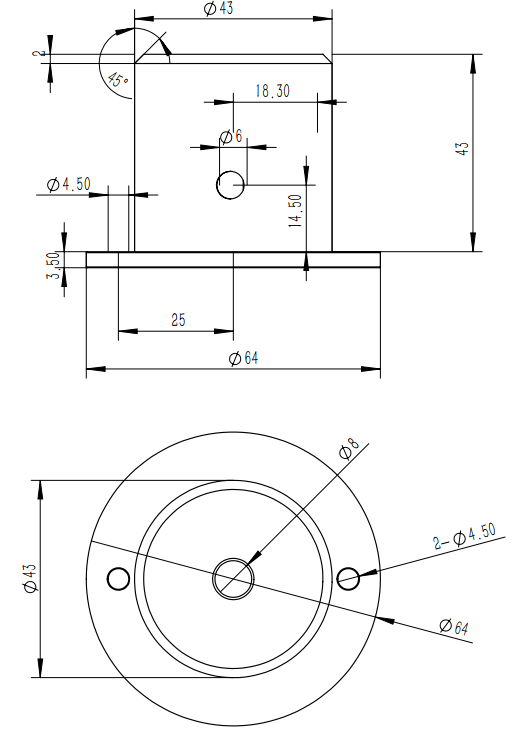

— Blogs —
—Products—
 Consumer hotline +8618073152920
Consumer hotline +8618073152920 WhatsApp:+8615367865107
Address:Room 102, District D, Houhu Industrial Park, Yuelu District, Changsha City, Hunan Province, China
Product knowledge
Time:2023-12-07 15:15:22 Popularity:1000
The main purpose of the PAR Sensor is to measure photosynthetically active radiation (PAR), an instrument used to measure the amount of light energy required by plants in the light.The PAR Sensor can detect light in the range of 400-700 nanometers, which happens to be the range of wavelengths required by plants for photosynthesis. Therefore, PAR sensors can be used to study the ecology, physiology and biogeochemistry of plants.
The photosynthetically active radiation sensor (PAR SENSOR) is used to measure PAR in the spectral range of 400-700 nm. It uses the principle of photoelectric sensing and can measure the light radiation energy used by plants for photosynthesis.
The wavelength range of 400~700nm is the portion of solar radiation that is used by vegetation for photosynthesis. Photosynthetically active radiation is the formation of biomass of the basic energy, control the land biological effective photosynthesis rate, directly affecting the growth, development, yield and quality of plants, at the same time, photosynthetically active radiation is also an important climatic resources, affecting the surface and the atmospheric environment material, energy exchange.

What is the use of photosynthetically active radiation sensor?
Photosynthetically active radiation sensors can be used in greenhouse and facility agriculture to provide good data support for utilizing solar radiation. Specifically, through the measurement of effective photosynthetic radiation in the greenhouse, you can grasp the light intensity in the greenhouse, assess the light environment in the greenhouse, provide a basis for the selection of crop varieties suitable for cultivation in the greenhouse, and also control the greenhouse automatic shuttering device according to the effective photosynthetic radiation.
In addition, the photosynthetically active radiation sensor can also be used for greenhouse and grow box lighting monitoring, agricultural yield research, micrometeorological research, and so on. When there is light irradiation, this sensor will produce a voltage signal proportional to the intensity of the incident radiation, thus providing data support for us to utilize the photosynthetically active radiation.
Photosynthetically active radiation sensors can be used in a number of scenarios, including but not limited to:
Greenhouse, facility agriculture: to make good data support for the use of solar radiation, measuring the effective photosynthetic radiation in the greenhouse, mastering the light intensity in the greenhouse, assessing the light environment in the greenhouse, providing a basis for the selection of crop varieties suitable for planting in the greenhouse, and controlling the greenhouse automatic shuttering device based on the effective photosynthetically active radiation.
Agricultural yield research: Photosynthetically active radiation sensors can be used to study the photosynthetic efficiency of different crop varieties, as well as the impact of different environmental conditions on crop yield.
Micro-meteorological research: Photosynthetically active radiation sensors can be used to study the process of photosynthesis under micro-meteorological conditions, such as the effects of climate change on plant growth and yield in special environments such as plateaus and mountainous regions.
Ecological environment monitoring: Photosynthetically active radiation sensors can be used to monitor the intensity of photosynthetically active radiation in ecological environments, for example, changes in ecosystems such as forests and wetlands, in order to assess its impact on the entire ecosystem.
Solar energy utilization: Photosynthetically active radiation sensors can be used to monitor and optimize the photovoltaic conversion efficiency of solar panels in order to improve the efficiency of solar energy utilization.
Overall, photosynthetically active radiation sensors have a wide range of application scenarios, and PAR sensors are also widely used in agriculture, ecology, meteorology, solar energy, and environmental monitoring. In agriculture, PAR sensors can help farmers determine the state of crop growth and improve the yield and quality of crops. In ecology, PAR sensors can help scientists understand the response of plants to the environment and study the ecological processes of ecosystems. In meteorology and environmental monitoring, PAR sensors can be used to measure the amount of sunshine, air quality, and cyanobacteria in water bodies.
Related recommendations
Sensors & Weather Stations Catalog
Agriculture Sensors and Weather Stations Catalog-NiuBoL.pdf
Weather Stations Catalog-NiuBoL.pdf
Related products
 Combined air temperature and relative humidity sensor
Combined air temperature and relative humidity sensor Soil Moisture Temperature sensor for irrigation
Soil Moisture Temperature sensor for irrigation Soil pH sensor RS485 soil Testing instrument soil ph meter for agriculture
Soil pH sensor RS485 soil Testing instrument soil ph meter for agriculture Wind Speed sensor Output Modbus/RS485/Analog/0-5V/4-20mA
Wind Speed sensor Output Modbus/RS485/Analog/0-5V/4-20mA Tipping bucket rain gauge for weather monitoring auto rainfall sensor RS485/Outdoor/stainless steel
Tipping bucket rain gauge for weather monitoring auto rainfall sensor RS485/Outdoor/stainless steel Pyranometer Solar Radiation Sensor 4-20mA/RS485
Pyranometer Solar Radiation Sensor 4-20mA/RS485
Screenshot, WhatsApp to identify the QR code
WhatsApp number:+8615367865107
(Click on WhatsApp to copy and add friends)